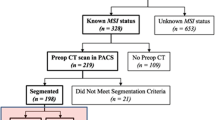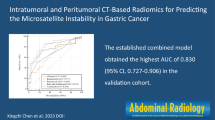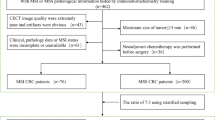Abstract
Purpose
To construct and validate a radiomics feature model based on computed tomography (CT) images and clinical characteristics to predict the microsatellite instability (MSI) status of gastric cancer patients before surgery.
Methods
We retrospectively collected the upper abdominal or the entire abdominal-enhanced CT scans of 189 gastric cancer patients before surgery. The patients underwent postoperative gastric cancer MSI status testing, and the dates of their radiologic images and clinicopathological data were from January 2015 to August 2021. These 189 patients were divided into a training set (n = 90) and an external validation set (n = 99). The patients were divided by MSI status into the MSI-high (H) arm (30 and 33 patients in the training set and external validation set, respectively) and MSI-low/stable (L/S) arm (60 and 66 patients in the training set and external validation set, respectively). In the training set, the clinical characteristics and tumor radiologic characteristics of the patients were extracted, and the tenfold cross-validation method was used for internal validation of the training set. The external validation set was used to assess its generalized performance. A receiver-operating characteristic (ROC) curve was plotted to assess the model performance, and the area under the curve (AUC) was calculated.
Results
The AUC of the radiomics model in the training set and external validation set was 0.8228 [95% confidence interval (CI) 0.7355–0.9101] and 0.7603 [95% CI 0.6625–0.8581], respectively, showing that the constructed radiomics model exhibited satisfactory generalization capabilities. The accuracy, sensitivity, and specificity of the training dataset were 0.72, 0.63, and 0.77, respectively. The accuracy, sensitivity, and specificity of the external validation dataset were 0.67, 0.79, and 0.60, respectively. Statistical analysis was carried out on the clinical data, and there was statistical significance for the tumor site and age (p < 0.05). MSI-H gastric cancer was mostly seen in the gastric antrum and older patients.
Conclusions
Radiomics markers based on CT images and clinical characteristics have the potential to be a non-invasive auxiliary diagnostic tool for preoperative assessment of gastric cancer MSI status, and they can aid in clinical decision-making and improve patient outcomes.
Graphical abstract









Similar content being viewed by others
Abbreviations
- MSI:
-
Microsatellite instability
- CT:
-
Computed tomography
- AUC:
-
Area under the curve
- ROC:
-
Receiver operating curve
- NCCN:
-
National comprehensive cancer network
- MMR:
-
Mismatch repair
- MSI-H:
-
MSI-high frequency
- MSI-L:
-
MSI-low frequency
- MSS:
-
MSI stability
- VOI:
-
Volume of interest
- ROI:
-
Region of interest
- DNA:
-
Deoxyribonucleic acid
- FDA:
-
Food and Drug Administration
- GLCM:
-
Gray-level co-occurrence matrix
- GLRLM:
-
Gray-level run length matrix
- GLSZM:
-
Gray-level size zone matrix
- GLDM:
-
Gray-level dependence matrix
- NGTDM:
-
Neighborhood gray-tone difference matrix
References
Sung H, Ferlay J, Siegel RL, et al. Global Cancer Statistics 2020: GLOBOCAN Estimates of Incidence and Mortality Worldwide for 36 Cancers in 185 Countries. CA Cancer J Clin 2021; 71:209-249
Cristescu R, Lee J, Nebozhyn M, et al. Molecular analysis of gastric cancer identifies subtypes associated with distinct clinical outcomes. Nat Med 2015; 21:449-456
Bonneville R, Krook MA, Kautto EA, et al. Landscape of Microsatellite Instability Across 39 Cancer Types. JCO Precis Oncol 2017; 2017
Liu X, Meltzer SJ. Gastric Cancer in the Era of Precision Medicine. Cell Mol Gastroenterol Hepatol 2017; 3:348-358
Cai L, Sun Y, Wang K, et al. The Better Survival of MSI Subtype Is Associated With the Oxidative Stress Related Pathways in Gastric Cancer. Front Oncol 2020; 10:1269
van Velzen MJM, Derks S, van Grieken NCT, Haj Mohammad N, van Laarhoven HWM. MSI as a predictive factor for treatment outcome of gastroesophageal adenocarcinoma. Cancer Treat Rev 2020; 86:102024
Zhao L, Zhang J, Qu X, et al. Microsatellite Instability-Related ACVR2A Mutations Partially Account for Decreased Lymph Node Metastasis in MSI-H Gastric Cancers. Onco Targets Ther 2020; 13:3809-3821
Bibeau F. The MSI status: An almost ideal marker! Ann Pathol 2017; 37:439-440
Duffy MJ, Crown J. Biomarkers for Predicting Response to Immunotherapy with Immune Checkpoint Inhibitors in Cancer Patients. Clin Chem 2019; 65:1228-1238
Rodriquenz MG, Roviello G, D'Angelo A, Lavacchi D, Roviello F, Polom K. MSI and EBV Positive Gastric Cancer's Subgroups and Their Link With Novel Immunotherapy. J Clin Med 2020; 9
Raimondi A, Palermo F, Prisciandaro M, et al. TremelImumab and Durvalumab Combination for the Non-OperatIve Management (NOM) of Microsatellite InstabiliTY (MSI)-High Resectable Gastric or Gastroesophageal Junction Cancer: The Multicentre, Single-Arm, Multi-Cohort, Phase II INFINITY Study. Cancers (Basel) 2021; 13
Svrcek M. Vers un screening systématique du statut MMR déficient/MSI sur toutes les biopsies de cancers de l’estomac. Ann Pathol 2019; 39:381-382
Fukuda M, Yokozaki H, Shiba M, Higuchi K, Arakawa T. Genetic and epigenetic markers to identify high risk patients for multiple early gastric cancers afte r treatment with endoscopic mucosal resection. J Clin Biochem Nutr 2007; 40:203-209
Berry P, Kotha S, Tritto G, DeMartino S. A three-tiered approach to investigating patient safety incidents in endoscopy: 4-year experience in a teaching hospital. Endosc Int Open 2021; 9:E1188-e1195
Kim GH. Systematic Endoscopic Approach for Diagnosing Gastric Subepithelial Tumors. Gut Liver 2022; 16:19-27
Gillies RJ, Kinahan PE, Hricak H. Radiomics: Images Are More than Pictures, They Are Data. Radiology 2016; 278:563-577
Compter I, Verduin M, Shi Z, et al. Deciphering the glioblastoma phenotype by computed tomography radiomics. Radiother Oncol 2021; 160:132-139
Wang W, Cao K, Jin S, Zhu X, Ding J, Peng W. Differentiation of renal cell carcinoma subtypes through MRI-based radiomics analysis. Eur Radiol 2020; 30:5738-5747
Li C, Yin J. Radiomics Nomogram Based on Radiomics Score from Multiregional Diffusion-Weighted MRI and Clinical Factors for Evaluating HER-2 2+ Status of Breast Cancer. Diagnostics (Basel) 2021; 11
Li Z, Zhong Q, Zhang L, et al. Computed Tomography-Based Radiomics Model to Preoperatively Predict Microsatellite Instability Status in Colorectal Cancer: A Multicenter Study. Front Oncol 2021; 11:666786
Cao Y, Zhang G, Zhang J, et al. Predicting Microsatellite Instability Status in Colorectal Cancer Based on Triphasic Enhanced Computed Tomography Radiomics Signatures: A Multicenter Study. Front Oncol 2021; 11:687771
Huang Z, Zhang W, He D, et al. Development and validation of a radiomics model based on T2WI images for preoperative prediction of microsatellite instability status in rectal cancer: Study Protocol Clinical Trial (SPIRIT Compliant). Medicine (Baltimore) 2020; 99:e19428
Zhang W, Huang Z, Zhao J, et al. Development and validation of magnetic resonance imaging-based radiomics models for preoperative prediction of microsatellite instability in rectal cancer. Ann Transl Med 2021; 9:134
Zhang W, Yin H, Huang Z, et al. Development and validation of MRI-based deep learning models for prediction of microsatellite instability in rectal cancer. Cancer Med 2021; 10:4164-4173
Kim JY, Shin NR, Kim A, et al. Microsatellite instability status in gastric cancer: a reappraisal of its clinical significance and relationship with mucin phenotypes. Korean J Pathol 2013; 47:28-35
Miyamoto N, Yamamoto H, Taniguchi H, et al. Differential expression of angiogenesis-related genes in human gastric cancers with and those without high-frequency microsatellite instability. Cancer Lett 2007; 254:42-53
Choi J, Nam SK, Park DJ, et al. Correlation between microsatellite instability-high phenotype and occult lymph node metastasis in gastric carcinoma. APMIS 2015; 123:215-222
Wu MS, Lee CW, Shun CT, et al. Distinct clinicopathologic and genetic profiles in sporadic gastric cancer with different mutator phenotypes. Genes Chromosomes Cancer 2000; 27:403-411
Chung HW, Lee SY, Han HS, et al. Gastric cancers with microsatellite instability exhibit high fluorodeoxyglucose uptake on positron emission tomography. Gastric Cancer 2013; 16:185-192
Shah MA, Khanin R, Tang L, et al. Molecular classification of gastric cancer: a new paradigm. Clin Cancer Res 2011; 17:2693-2701
Polom K, Marrelli D, Roviello G, et al. Molecular key to understand the gastric cancer biology in elderly patients-The role of microsatellite instability. J Surg Oncol 2017; 115:344-350
Author information
Authors and Affiliations
Corresponding author
Additional information
Publisher's Note
Springer Nature remains neutral with regard to jurisdictional claims in published maps and institutional affiliations.
Rights and permissions
About this article
Cite this article
Liang, X., Wu, Y., Liu, Y. et al. A multicenter study on the preoperative prediction of gastric cancer microsatellite instability status based on computed tomography radiomics. Abdom Radiol 47, 2036–2045 (2022). https://doi.org/10.1007/s00261-022-03507-3
Received:
Revised:
Accepted:
Published:
Issue Date:
DOI: https://doi.org/10.1007/s00261-022-03507-3




